>
Scombriformes (Mackerels) >
Scombridae (Mackerels, tunas, bonitos) > Scombrinae
Etymology: Scomberomorus: Latin, scomber = mackerel + Greek, moros = silly, stupid (Ref. 45335).
More on author: Bloch.
Environment: milieu / climate zone / depth range / distribution range
Ecologia
marinhas associadas(os) a recifes; oceanódromo (Ref. 51243); intervalo de profundidade 1 - 20 m (Ref. 9710), usually 1 - ? m (Ref. 55288). Tropical; 41°N - 24°S, 99°W - 34°W
Western Atlantic: Massachusetts, USA to Brazil, including the Bahamas and West Indies.
Comprimento de primeira maturação / Tamanho / Peso / Idade
Maturity: Lm 40.5, range 38 - ? cm
Max length : 183 cm TL macho/indeterminado; (Ref. 26340); peso máx. publicado: 7.8 kg (Ref. 4699)
Espinhos dorsais (total) : 16 - 18; Raios dorsais (total) : 15 - 19; Espinhos anais: 0; Raios anais : 15 - 20; Vértebras: 47 - 48. Interpelvic process small and bifid. Lateral line gently curving down toward caudal peduncle. Intestine with 2 folds and 3 limbs. Swim bladder absent. Body covered with small scales. Anterior third of first dorsal fin black. Pelvic fins relatively long. Sides silvery with one long mid-lateral stripe and with several rows of yellow-orange streaks of variable length and small yellow spots above and below the stripe.
Most abundant in clear waters around coral reefs, occasionally forming schools. Feeds on clupeoids (Harengula, Jenkinsia and Opisthonema) and atherinids (Allanetta [= Craterocephalus), squids and shrimps. Good food and game fish (Ref. 5521). Utilized fresh, smoked and frozen; consumed pan-fried, broiled and baked (Ref. 9987). Sometimes called the "Painted Mackerel" (Ref. 13442).
Collette, B.B. and C.E. Nauen, 1983. FAO Species Catalogue. Vol. 2. Scombrids of the world. An annotated and illustrated catalogue of tunas, mackerels, bonitos and related species known to date. Rome: FAO. FAO Fish. Synop. 125(2):137 p. (Ref. 168)
Status na Lista Vermelha da UICN (Ref. 130435)
Ameaça para os humanos
Reports of ciguatera poisoning (Ref. 9987)
Uso pelos humanos
Pescarias: pouco comercial; peixe esportivo: sim
Ferramentas
Relatórios especiais
Baixar XML
Fontes da internet
Estimates based on models
Preferred temperature (Ref.
123201): 23.4 - 28.1, mean 27.3 °C (based on 977 cells).
Índice de diversidade filogenética (Ref.
82804): PD
50 = 0.5000 [Uniqueness, from 0.5 = low to 2.0 = high].
Bayesian length-weight: a=0.00977 (0.00522 - 0.01830), b=3.01 (2.86 - 3.16), in cm total length, based on LWR estimates for this species & Genus-body shape (Ref.
93245).
Nível Trófico (Ref.
69278): 4.5 ±0.4 se; based on diet studies.
Resiliência (Ref.
120179): médio(a), tempo mínimo de duplicação da população 1,4 - 4,4 anos (Fec=160,000; assuming tm=2-4).
Prior r = 0.37, 95% CL = 0.25 - 0.56, Based on 1 data-limited stock assessment.
Fishing Vulnerability (Ref.
59153): Very high vulnerability (90 of 100).
Climate Vulnerability (Ref.
125649): High vulnerability (57 of 100).
Nutrients (Ref.
124155): Calcium = 8.08 [3.23, 27.36] mg/100g; Iron = 0.327 [0.126, 0.834] mg/100g; Protein = 21.2 [19.7, 22.7] %; Omega3 = 0.113 [0.070, 0.193] g/100g; Selenium = 39.6 [12.7, 130.5] μg/100g; VitaminA = 66.6 [12.9, 341.5] μg/100g; Zinc = 0.541 [0.330, 0.918] mg/100g (wet weight);
